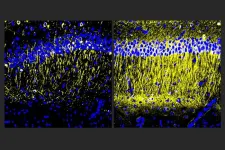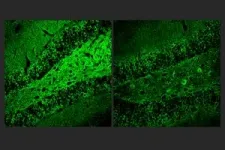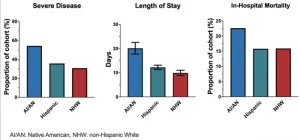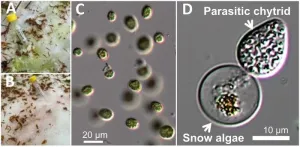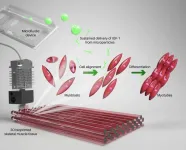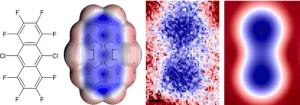(Press-News.org) Though drug developers have achieved some progress in treating Alzheimer’s disease with medicines that reduce amyloid-beta protein, other problems of the disease including inflammation, continue unchecked. In a new study, scientists at The Picower Institute for Learning and Memory at MIT describe a candidate drug that in human cell cultures and Alzheimer’s mouse models reduced inflammation and improved memory.
The target of the new “A11” molecule is a genetic transcription factor called PU.1. Prior research has shown that amid Alzheimer’s disease, PU.1 becomes an overzealous director of inflammatory gene expression in the brain’s microglia immune cells. A11 suppresses this problematic PU.1 activity, the new research shows, by recruiting other proteins that repress the inflammatory genes PU.1 works to express. But because A11 concentrates mostly in the brain and does not reduce PU.1 levels, it does not appear to disrupt PU.1’s other job, which is to ensure the production of a wide variety of blood cells.
“Inflammation is a major component of Alzheimer’s disease pathology that has been especially hard to treat,” said study senior author Li-Huei Tsai, Picower Professor of Neuroscience at MIT and director of The Picower Institute and MIT’s Aging Brain Initiative. “This preclinical study demonstrates that A11 reduces inflammation in human microglia-like cells as well as in multiple mouse models of Alzheimer’s disease and significantly improves cognition in the mice. We believe A11 therefore merits further development and testing.”
Tsai and Elizabeta Gjoneska of the National Institutes of Health are co-corresponding authors of the study published in the Journal of Experimental Medicine.
As a postdoc, Gjoneska co-led a 2015 study that implicated PU.1 as a regulator of errant microglia inflammation in a mouse model of Alzheimer’s disease. That research was a collaboration between Tsai’s lab and that of MIT Computer Science Professor Manolis Kellis, co-led by former postdoc Andreas Pfenning, now a faculty member at Carnegie Mellon University. Ever since then, Tsai has been seeking a safe way to restore PU.1 activity to healthier levels.
The work described in the new paper, led by Picower Institute research scientist William Ralvenius, starts with experiments to further validate that PU.1 would be a therapeutically meaningful target. To do that the scientists compared gene expression in immune cells of postmortem brain samples from Alzheimer’s patients and mouse models and matching non-Alzheimer’s controls. The comparisons showed that Alzheimer’s effects major changes in microglial gene expression and that an increase in PU.1 binding to inflammatory gene targets was a significant component of that change. Moreover, they showed that reducing PU.1 activity in a mouse model of Alzheimer’s reduced inflammation and neurodegeneration, the death of neurons.
Screening success
Genetically knocking down PU.1 in the body is not a viable therapeutic strategy given its importance in normal healthy function. The team therefore screened more than 58,000 small molecules from libraries of FDA-approved drugs and novel chemicals to see if any could safely and significantly reduce key inflammation and Alzheimer’s related genes regulated by by PU.1 in cell cultures. After several rounds of increasingly stringent screening, they narrowed the field down to six chemicals. A11 was by far the most potent among them.
They tested the effects of A11 doses on the function of human microglia-like cells cultured from patient stem cells. When they exposed the microglia-like cells to immune molecules that typically trigger inflammation, cells dosed with A11 exhibited reduced expression and secretion of inflammatory cytokines and less of the cell body shape changes associated with microglia inflammatory responses. The cells also showed less accumulation of lipid molecules, another sign of inflammatory activation. Looking at gene expression patterns, the scientists observed that A11-treated cells exposed to inflammatory triggers behaved much like unperturbed microglia, suggesting that A11 helps prevent microglia from overreacting to inflammatory cues.
Two more lab tests aimed at understanding how A11 exerts its effects revealed that it doesn’t change PU.1 levels. Instead it counteracts PU.1 activity by recruiting several proteins including MECP2, HDAC1, SIN3A and DMNT3A, known to repress expression of its targets. Essentially amid Alzheimer’s disease, A11 tamps down what PU.1 amps up.
“A11 represents a first-in-class molecule that converts PU.1 from a transcriptional activator to a transcriptional repressor, resulting in a controlled state of microglial inflammation,” the authors wrote.
Mice in mazes
Having established that A11 reduced inflammatory activity in microglia and determined how that happens, the team focused on whether it worked as a medicine in mouse models of Alzheimer’s disease.
Pharmacological tests indicated that A11 is readily cleared from tissues and is capable of reaching brain cells. Moreover, in healthy mice the chemical successfully crossed the blood-brain barrier and remained in brain cells much longer than anywhere else.
Finally the team tested the effects of the drugs on Alzheimer’s disease pathology and symptoms in three mouse strains that each model different aspects of Alzheimer’s disease: CK-p25 mice (severe neurodegeneration), Tau P301S transgenic mice (tauopathy), and 5XFAD mice (amyloid pathology).
Male and female CK-p25 mice dosed with A11 showed less inflammatory response among microglia and astrocyte cells and lost fewer neurons than untreated controls. TauP301S Tg mice responded similarly, also exhibiting a significant reduction of phosphorylated tau protein in the hippocampus region of the brain, which is an essential area for memory. In 5XFAD mice, amyloid was significantly reduced.
The team subjected the Tau P301S Tg and CK-p25 mice to mazes designed to test their short-term working memory and longer-term learning. In both models and on both tests, A11-treated mice performed significantly better than untreated controls. For example, in the “Morris Water Maze,” where mice have to learn the location of a submerged platform that allows them to rest, treated CK-p25 mice learned much faster than untreated ones.
Much more testing needs to be done before A11 could become an approved medicine, Tsai said, but she noted that it could complement the new treatments that target amyloid.
“Given that A11 acts via a distinct mechanism from existing AD therapeutics, A11 could be used alone or in combination with approved therapeutics to provide improved treatment options for neurodegenerative diseases,” the authors concluded.
In addition to Tsai, Gjoneska and Ralvenius, the paper’s other authors are Alison E. Mungenast, Hannah Woolf, Margaret M. Huston, Tyler Z. Gillingham, Stephen K. Godin, Jay Penney, Hugh P. Cam, Fan Gao, Celia G. Fernandez, Barbara Czako, Yaima Lightfoot, William J. Ray, Adrian Beckmann, Alison M. Goate, Edoardo Marcora, Carmen Romero-Molina, Pinar Ayata, and Anne Schaefer.
The Robert A. and Renee E. Belfer Family Foundation and the National Institutes of Health funded the research. Additional support came from The JPB Foundation and The Picower Institute for Learning and Memory, The Halis Family Foundation, Lester A. Gimpelson and Jay L. and Caroll Miller.
END
Molecule reduces inflammation in Alzheimer’s models
2023-08-29
ELSE PRESS RELEASES FROM THIS DATE:
Disproportionate impact of COVID-19 on American Indians
2023-08-29
A study of COVID-19 patients at a New Mexico hospital finds that the virus hit American Indian patients particularly hard—even though Native American patients had fewer other illnesses or conditions than non-native patients. Douglas Perkins and colleagues analyzed data on 475 patients with COVID-19 infections from the University of New Mexico Hospital. The sample was 30.7% Native American, 47% Hispanic, and 18.5% non-Hispanic White. At admission, Native American patients were younger, more likely to need ...
Novel SwRI-developed antenna array wins 2023 R&D 100 Award
2023-08-29
SAN ANTONIO — August 29, 2023 —Novel Southwest Research Institute-developed direction-finding technology has won a prestigious R&D 100 Award. R&D World Magazine has recognized SwRI’s Wideband Conformal Continuous-Slot Antenna Array as one of the 100 most significant innovations for 2023.
“Southwest Research Institute strives to uncover innovative solutions to complex problems,” said SwRI President and CEO Adam L. Hamilton, P.E. “I am very proud of the work SwRI does and pleased to know this technology, which will provide significant support to naval operations, has been recognized as one of the most important innovations ...
Texas Biomed partners with Scancell to test novel COVID vaccine
2023-08-29
SAN ANTONIO (Aug. 29, 2023) – A DNA-based vaccine is very effective at protecting against COVID-19, according to a joint preclinical study by Scancell Ltd and Texas Biomedical Research Institute (Texas Biomed) recently published in the Journal of Biotechnology and Biomedicine.
Unlike the Pfizer and Moderna COVID-19 vaccines that use messenger RNA (mRNA) to cue the immune system to produce antibodies, this vaccine platform uses sections of viral DNA to achieve a similar result.
“There is always a need to develop new, or improve on existing vaccines to ensure we have effective tools to counter emerging variants,” says Texas Biomed Innovation ...
Chytrid fungi revealed to be parasitic species that infects snow algae
2023-08-29
The microbial communities found in glacier and snowpack ecosystems are an essential part of cold weather environments. Chytrids, a group of fungi that include well-known frog pathogens, are often found in abundance in these ecosystems, but culturing these organisms and learning more about their lifecycle, including their relationship to the snow algae found in these environments, has proven challenging.
In a recently published paper, researchers revealed that they were able to analyze chytrid DNA from two alpine snowpack sites in Japan using single-spore PCR.
The paper was published in Frontiers in Microbiology on June 20.
“We have captured the chytrids ...
New and improved bioink to enhance 3D bioprinted skeletal muscle constructs
2023-08-29
(LOS ANGELES) – August 29, 2023 - An advancement in 3D bioprinting of native-like skeletal muscle tissues has been made by scientists at the Terasaki Institute for Biomedical Innovation (TIBI). The key to the TIBI scientists’ approach lies in their specially formulated bioink, which contains microparticles engineered for sustained delivery of insulin-like growth factor-1 (IGF-1). As was shown in their recent paper in Macromolecular Bioscience, sustained delivery of IGF-1 enhances the formation of mature skeletal muscle tissue from muscle precursor cells and facilitates their structural alignment. This increases the efficiency of the regenerative process ...
Scientists continue to push the boundaries of imaging techniques and reveal the mysterious world of molecules
2023-08-29
Scientists from the IOCB Prague, the Institute of Physics of the Czech Academy of Sciences, and Palacký University Olomouc, have once again successfully uncovered the mysteries of the world of molecules and atoms. They have experimentally confirmed the correctness of a decades-old theory that assumed a non-uniform distribution of electron density in aromatic molecules. This phenomenon significantly affects the physicochemical properties of molecules and their interactions. This research expands the possibilities for designing new nanomaterials and is the theme of a paper that has just been published in Nature Communications.
The ...
Prescription for fruits, vegetables linked to better heart health, food security
2023-08-29
Research Highlights:
Adults at risk for heart disease who participated in produce prescription programs for an average of six months increased their consumption of fruits and vegetables and had reduced blood pressure, body mass index and blood sugar levels.
Among adults and children, produce prescription programs also appeared to decrease food insecurity — the lack of equitable and stable availability, access, affordability and consumption of healthy foods and drinks — and improve self-reported health status.
Embargoed until 4 a.m. CT/5 a.m. ET Tuesday, August 29, 2023
DALLAS, August 29, 2023 — ...
Wildfire, soil emissions increasing air pollution in remote forests
2023-08-29
Satellite data from across California’s landscapes reveal an increase in nitrogen dioxide levels in remote forest areas, and wildfire and soil emissions are likely the reasons why, according to a paper from University of California, Davis, published today in the journal Environmental Research Letters.
Nitrogen dioxide is short-lived in the atmosphere but plays a central role in the formation of the pollutants ozone and particulate matter, which can lead to respiratory issues and asthma in humans, as well as harm plants and crop yields.
The researchers looked at summertime surface and satellite concentrations of nitrogen dioxide between 2009 ...
Can an artificial kidney finally free patients from dialysis?
2023-08-29
Scientists at UC San Francisco are working on a new approach to treating kidney failure that could one day free people from needing dialysis or having to take harsh drugs to suppress their immune system after a transplant.
They have shown for the first time that kidney cells, housed in an implantable device called a bioreactor, can survive inside the body of a pig and mimic several important kidney functions. The device can work quietly in the background, like a pacemaker, and does not trigger the recipient’s immune system to go on the attack.
The ...
Researchers discover common origin behind major childhood allergies
2023-08-29
Several major childhood allergies may all stem from the community of bacteria living in our gut, according to a new study led by researchers at the University of British Columbia and BC Children’s Hospital.
The research, published in Nature Communications, identifies gut microbiome features and early life influences that are associated with children developing any of four common allergies — eczema, asthma, food allergy and/or hay fever. The findings could lead to methods of predicting whether a child will develop allergies, and ways to prevent them from developing at all.
“We’re ...
